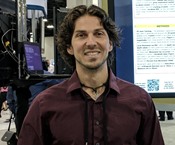Program Information
Facial Recognition and Recall Using Kinect V2 for Patient Verification
E Silverstein1*, M Snyder2 , (1) Wayne State University, Detroit, MI, (2) Wayne State University, Detroit, MI
Presentations
MO-FG-CAMPUS-TeP1-2 (Monday, August 1, 2016) 4:30 PM - 5:00 PM Room: ePoster Theater
Purpose: Investigate capability and accuracy of the Kinect v2 camera for facial recognition to use as a tool for patient check-in upon arrival, as well as patient verification when entering treatment vault.
Methods: The Kinect software has a native facial recognition feature which recognizes major facial landmarks (eyes, nose, mouth, etc). 1347 facial vertices are automatically generated, each located at a specific facial point at standardized distances between points. Through a process of facial contour mapping, the vertices are modified such that their coordinates are specific to the imaged face. 35 of these vertices are labeled with specific landmarks on the face (Nose Tip, Right Cheek Center, Left Eye Mid Top, etc).
Using code written in C#, 595 3D vectors are calculated utilizing the 35 native modified vertices. For each initial acquisition, the vector magnitudes are saved to file. For each comparison acquisition, the difference of identical vector magnitudes is calculated between the current face and each face saved to file. The mean of all magnitude differences per face is taken as the determining factor for facial match with the smallest mean value between faces determining the correct match. A database 15 imaged faces was used for comparison. Initial acquisitions kept Pitch, Yaw, and Roll between -10 and 10 degrees and distance between 90-100 cm.
Results: Through 25 acquisitions varying Pitch, Yaw, and Roll between -10 to 10 degrees as well 50 acquisitions modifying the distance up to 300 cm for two different test faces, the program obtained 100% true positives.
Conclusion: This facial recognition and recall program has excellent potential to function as a clinical tool for patient verification and check-in given these results. Further study is necessary for acquisition of a sufficient database to ensure an acceptable true positive rate with increased population size.
Contact Email:

